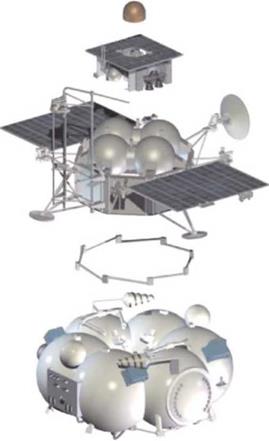A NEW BEGINNING RISES EROVI A CHERISHED LEGACY
The Phobos-Grunt spacecraft embraces the latest in space technology and erases the tradition of pressurized planetary spacecraft. The launcher will be the Zenit-Fregat. The Zenit rocket is a legacy of the Energiya-Ruran program, and the Fregat stage is a legacy from the Phobos and Mars-96 missions. For Phobos-Grunt to achieve the desired interplanetary trajectory, a burn of the spacecraft’s engine will be required after the Fregat burns out. The spacecraft will make the mideourse maneuvers, orbit insertion, and orbital maneuvers to rendezvous w ith and ultimately land on Phobos. the larger of the two Martian moons. Tradition also survives in the boldness of Russia’s return to robotic exploration: not just a modest step but an ambitious sample return mission, which seems appropriate for a program amongst whose unanswered legacies is a sample return from the Moon. Phobos-Grunt also continues the legacy of international cooperation, because it wall carry the first Chinese Mars spacecraft, Yinghuo 1, and release it into orbit around the planet.
The main goal of the Phobos-Grunt mission is to return a sample from Phobos to Earth for in-depth laboratory studies to help to answer key questions concerning the origin and evolution of the Solar System. The payload also includes instruments for navigation and for studying the Martian environment (television, space plasma and magnetic field detectors, and a dust particle detector) and instruments to study the surface of Phobos following the landing. The latter include a panoramic camera, gas
|
Figure 21.1 Phobos-Grunt spacecraft. At bottom ls the Frcgat propulsion stage, then (in turn) adapter ring, spacecraft-lander system, Earth return system and entry capsule (courtesy NrO-Lavochkin). |
chromatograph, gamma-ray spectrometer, neutron spectrometer, laser time-of’-llight mass spectrometer, secondary ion mass spectrometer, infrared spectrometer, thermal detector, long-wave subsurface radar and a seismometer. The robotic manipulator to be used for sampling carries a micro-television camera, an alpha, proton and x-ray spectrometer, and a Mossbauer spectrometer.
The Soviet lunar and planetary exploration program in the 20th Century left a legacy of scientific results and new knowledge. Tt is difficult to remember how little we knew about the Moon and planets at the beginning of the space age in 1957, and how much wc have learned as a result of sending out spacecraft. Table 21.1 provides a summary of the exploration milestones achieved by the Soviet program, most of which occurred during the first 15 years of the space age. Soviet scientists also made many scientific discoveries in the course of their missions. The early Luna missions established that whereas ihc near side of the Moon is dominated by the dark maria.
the far side is dominated by the bright highlands, an interesting dichotomy that has yet to he adequately explained. Lunar mass coneentrations were first discovered by Soviet spacecraft. Much of what we know of the atmosphere and surface of Venus eoincs from the Venera missions. And while the Soviets were thwarted at Mars, they were first to successfully land (albeit the lander failed after a few seconds), made the first in-situ measurements in the Martian atmosphere, the early discoveries about its ionosphere, and the lack of an intrinsic magnetic field.
The Phobos-Crunt mission represents a hope that Russia will resume a lunar and planetary exploration enterprise with the same boldness, innovation, and persistence that they demonstrated in the first 40 years of space exploration.
|
Table 21.1 ‘Firsts’ in lunar and planetary exploration by Soviet spacecraft
|











